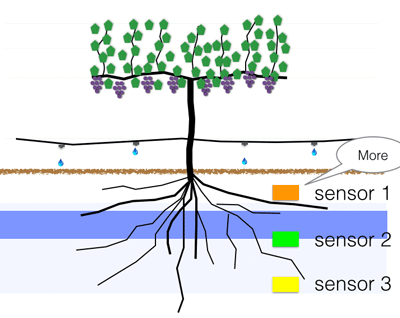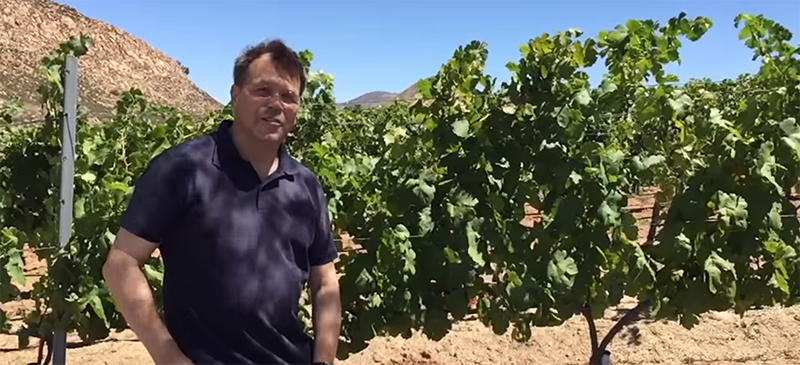Irrigation is a fairly crude practice. Sure, there are timers, and rain sensors, but all in all we’re basically dumping water on the ground and guessing at the right amount. [Reinier van der Lee] wanted a better way to ensure the plants in his vineyard are getting the right amount of water. And this is Goldilocks’ version of “right”, not too little but also not too much. Southern California is in an extreme/exceptional drought. Water costs a lot of money, but it is also scarce and conservation has a wider impact than merely the bottom line.
His solution is the Vinduino project. It’s a set of moisture sensors that work in conjunction with a handheld device to measure the effect of irrigation. Multiple moisture sensors are buried at different depths: near the surface, at root level, and below root level. This lets you know when the water is getting to the root system, and when it has penetrated further than needed. The project was recognized as the Best Product in the 2015 Hackaday Prize, and [Reinier] presented the project during his talk at the Hackaday SuperConference. Check out the video of that talk below, and join us after the break for a look at the development of this impressive product.
[Reinier] is a transplant to Southern California, and in 2010, after a few years working with a suit and tie, he decided to buy a vineyard. 2011 would mark the beginning of one of the worst droughts in the history of California, and [Reinier] needed a better way to keep track of the water consumption of his vines.
The idea behind Vinduino is to monitor soil moisture. For the last few years, he’s had help watering his vines with the the assistance of a vineyard management company that comes by once a week, figures out how much water the plants need, and turns on the irrigation.

Watering plants is tricky business. If you just turn the irrigation on, the water will percolate down through the soil and will eventually get to the roots. Making sure the roots of a plant get enough water is a little harder than just turning on a sprinkler; turn the water on too long, and the water will percolate deeper than the roots. Watering past the roots is wasteful, and if you’re fertilizing, some of those nutrients are washed away.
[Reinier]’s solution was multiple soil moisture sensors buried at different depths – two within the root zone and one below. By measuring moisture around these sensors, [Reinier] can calculate when to stop watering the vines. It’s a rather brilliant solution, as you can easily tell when a plant doesn’t have enough water, and solves the harder problem of detecting when it has too much.

The sensors themselves are impressive as well. They’re gypsum-based sensors made with Plaster of Paris in a PVC mold. Throw in a few stainless steel bolts and put some fiberglass mesh screen in the mold for reinforcement, and you have a moisture sensor that is simple enough to get the job done and cheap enough to distribute all around a vineyard.
Building an irrigation sensor that costs under a dollar is a great innovation, but that doesn’t mean anything unless the sensor can be easily integrated into an irrigation system. For this, [Reinier] has developed two types of readers, one handheld and another wireless node that will connect to an irrigation system. The handheld sensor is built around an Arduino Pro Mini, includes a character LCD display and two alligator clips. When a sensor is connected to these alligator clips, the sensor shows the relative moisture in the ground. The RF and WiFi board includes screw terminals for connecting three sensors and relays information wirelessly back to the irrigation control system.
In 2014, [Reinier] was still managing farm with the help of a vineyard management company, and in total spent about $4300 to make sure his plants were watered for an entire year. For 2015, he ran his vineyard with the Vinduino, eliminating the cost for the management company to come out and managed to use 25% less water. Not only did [Reinier] manage to save a 430,000 gallons of water, he also managed to recoup the costs of his Vinduino implementation in less than a year. If that’s not game changing for agriculture in California, nothing is.

















I for one, do not like my wine watered down!
B^)
From the country that gave us vino and ‘duino.
I have heard a thing or two about stress and poor yield but excellent vintage.
California wine futures, early teens anyone?
Not a vine expert here, but would you not save even more water if the irrigation is done directly in the soil, a little bit below the surface? Would assume you save a lot of evaporation.
roots also need oxygen, having water infiltrate the soil from the outside helps aerate it.
According to an article in a recent “Modern Farmer”, wine grapes grown in Europe are not irrigated at all by law (excepting new plantings and in cases of extreme drought). The California wine-growing region has a much higher average rainfall than most European wine-growing regions, yet irrigation is routine in California.
The argument is that irrigation produces a higher yield of lower quality grapes for making wine.
Watering a vine leading to poor quality wine is not true. Durring the growth lart of the season the vine will benifit from irrigation. When it comes to tbe ripening stage yes moderate water stress helps develop higher quality but moderate stress is the key. Simply not watering can kill vines. Water stress can be measured by water pressure in the leaves … like blood pressure in a human. Also in vineyard establishment watering imperative. Another good thing about irrigation is putting fertilizer in the drip lines. The plant tissue when examined can indicate when to water and when to add nutrients.